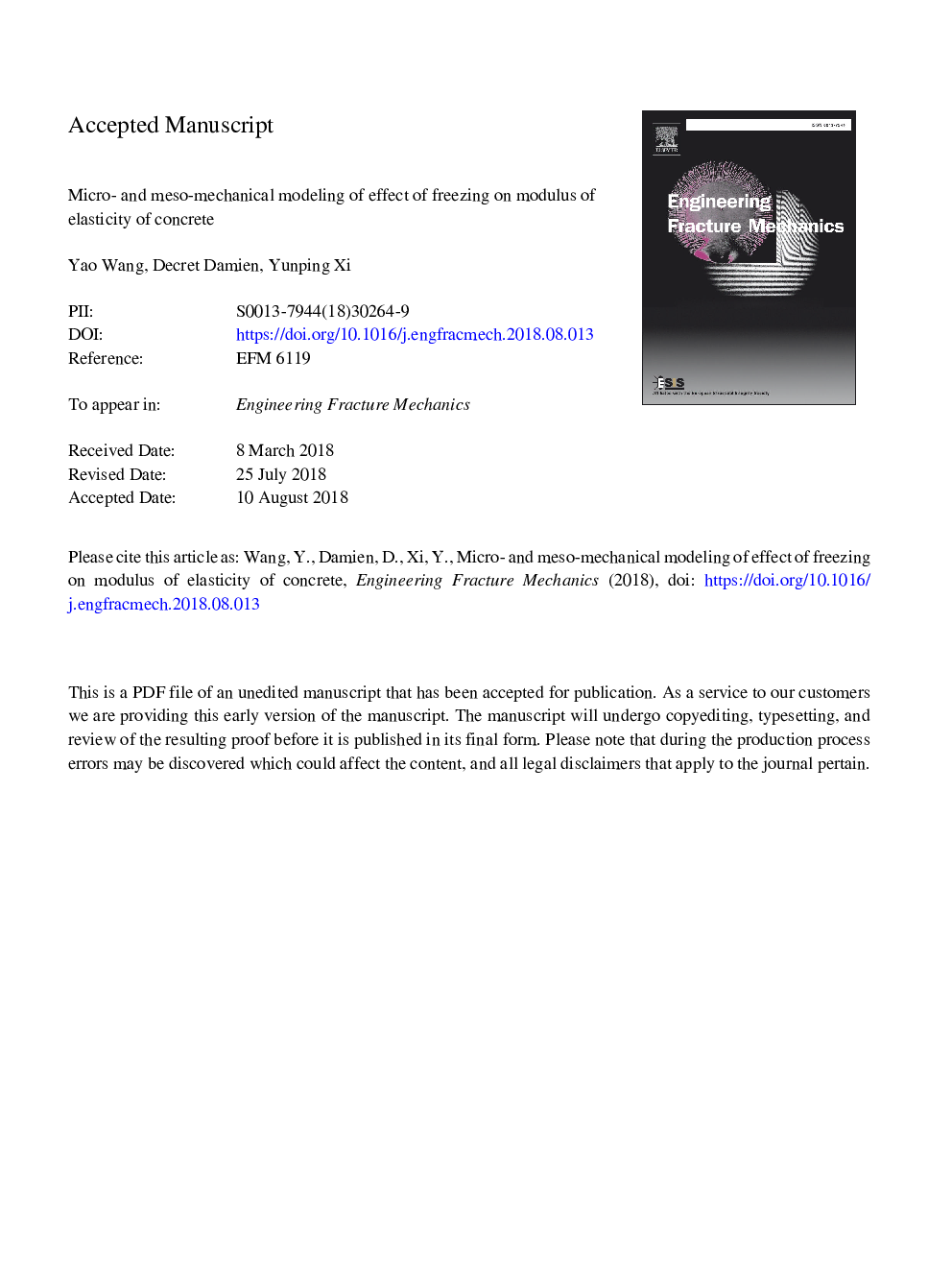| کد مقاله | کد نشریه | سال انتشار | مقاله انگلیسی | نسخه تمام متن |
|---|---|---|---|---|
| 11003869 | 1463029 | 2018 | 51 صفحه PDF | دانلود رایگان |
عنوان انگلیسی مقاله ISI
Micro- and meso-mechanical modeling of effect of freezing on modulus of elasticity of concrete
ترجمه فارسی عنوان
مدلسازی میکرو و مؤسسه مکانیکی اثر انجماد در مدول کشش بتن
دانلود مقاله + سفارش ترجمه
دانلود مقاله ISI انگلیسی
رایگان برای ایرانیان
کلمات کلیدی
مدول الاستیسیته، بتن، دمای پایین، مدل موری تاناکا،
ترجمه چکیده
تنوع مدول الاستیسیته بتن در دمای پایین بستگی به میزان یخ در ماده و میزان آسیب ناشی از تشکیل یخ دارد. در بازی تحت خنک کننده مداوم، دو اثر مخالف وجود دارد. یک اثر سخت افزاری به دلیل تشکیل یخ جامد در منافذ است زیرا سختی یخ بالاتر از آب مایع منفرد است و دیگر اثر ضعیف روند آسیب به دلیل شکل گیری مقدار زیاد یخ در منافذ که فشار بالا بر روی دیوار منافذ تولید می کند. هنگامی که اثر سفت کننده غالب است، سختی کلی ماده افزایش می یابد؛ و هنگامی که اثر ضعیف غالب است، سختی کلی مواد کاهش می یابد. یک نقطه عطفی در دمای وجود دارد که حالت متعادل دو اثر مخالف را نشان می دهد. نقطه چرخش به توزیع اندازه ذرات مواد سیمان بستگی دارد. مدل نظری، بر اساس مدل موری تاناکا، برای برآورد مدول کشش بتن در دمای پایین توسعه داده شد. این مدل بر اساس میکرومکانیک، توزیع اندازه منافذ، منحنی انجماد آب در منافذ اندازه های مختلف و آسیب رسانایی در خمیر سیمان است. پیش بینی های مدل نشان داد که هر دو اثر متضاد می تواند با مدل کنونی مشخص شود. پیش بینی های مدل توافق امیدبخش با داده های آزمایشی محدود موجود در ادبیات را نشان می دهد.
موضوعات مرتبط
مهندسی و علوم پایه
سایر رشته های مهندسی
مهندسی مکانیک
چکیده انگلیسی
The variation of modulus of elasticity of concrete under low temperatures depends on the amount of ice formed in the material and the extent of the damage induced by the formation of ice. There are two opposing effects at play under continuous cooling. One is the stiffening effect due to the formation of solid ice in pores because the stiffness of ice is higher than that of liquid pore water, and the other is the weakening effect of the damage process due to the formation of excessive amount of ice in pores which generates a high pressure on the pore wall. When the stiffening effect is dominant, the overall stiffness of the material increases; and when the weakening effect is dominant, the overall stiffness of the material decreases. There is a turning point in temperature representing the balanced state of the two opposing effects. The turning point depends on pore size distribution of cementitious materials. A theoretical model, based on the Mori-Tanaka model, was developed to estimate the modulus of elasticity of concrete under low temperatures. The model is based on micromechanics, pore size distribution, freezing curve of water in the pores of various sizes, and damage-plasticity in cement paste. The model predictions showed that both opposing effects can be characterized by the present model. Model predictions show promising agreement with limited experimental data available in the literature.
ناشر
Database: Elsevier - ScienceDirect (ساینس دایرکت)
Journal: Engineering Fracture Mechanics - Volume 200, September 2018, Pages 401-417
Journal: Engineering Fracture Mechanics - Volume 200, September 2018, Pages 401-417
نویسندگان
Yao Wang, Decret Damien, Yunping Xi,
